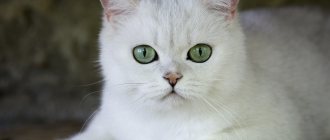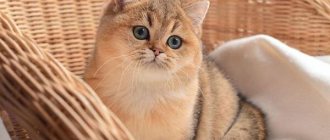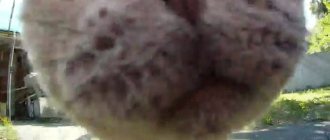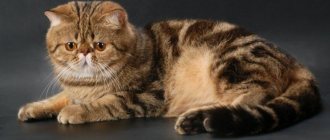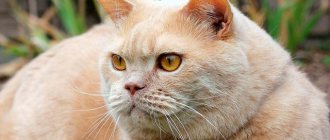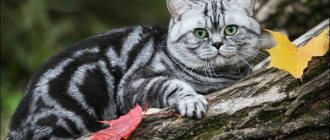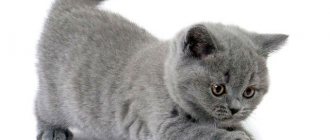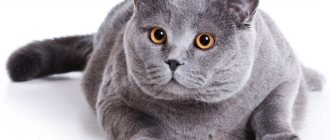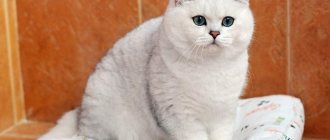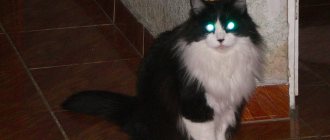The golden chinchilla is a cat that is not yet widely known, but has the name of a popular rodent. The breed appeared relatively recently, so many are able to appreciate the beauty of a cat only from a photo.
When looking at a photograph, you want not only to admire it again and again, but also to find out what it is like in reality, its habits and character, and even the possibility of acquisition.
Story
The history of Chinchillas begins in 1882, when, as a result of crossing British and Persian cats, offspring with an unusual coat color appeared. The owners were delighted and without hesitation decided to breed a new species with a color reminiscent of chinchillas. In 1889, a kitten was born who was given the nickname Silver Lambkin. He became the founder of the variety.
In addition to the silver color, the breeders wanted to fix the green color of the iris. For a long time they strived for this, diluting the blood of Chinchillas with other species. It is believed that not only Persians, but also Orientals, Burmese and other cats participated in the breeding of the breed.
Golden cat
Unfortunately, such mixing gave a negative result. The green color of the eyes was not fixed, and the kittens lost that very unique color of the Chinchilla.
Therefore, felinologists stopped experimenting, continuing only with intrabreed crossing. From time to time they added the blood of Persian cats, but no more.
In the end, the breeders took silver chinchillas as a basis and continued working on colors. They managed to bring out several shades at once: shaded gold and silver. Additionally, another variety of the breed arose - longhaired.
Princess Victoria liked unusual pets. Having settled them in her palace, she encouraged cat lovers to engage in a new subspecies. This is how breeding arose not only in Great Britain, but also in other European countries.
What are they?
Golden chinchillas come in short-haired and long-haired varieties. If it seems that caring for long hair is more difficult than short hair, then this is, of course, a misconception. Any animal needs care, and seasonal shedding simply cannot be avoided, either by animals with long or short hair. Everyone needs to be brushed constantly.
According to breed standards, golden chinchillas with green eyes are most often found, but options with blue and yellowish eye tints are not excluded. The blue color is mainly found in silver chinchillas.
Golden British chinchillas should not have a pronounced pattern on their coat; as a rule, these are soft and gentle transitions from one shade to another.
Registration
The British breed was first registered in 1980 by the CFA or Cat Fanciers' Association. Later, the British were recognized by a number of other international felinological organizations:
- WCF - World Cat Federation;
- FIFe - International Cat Federation;
- TICA - International Cat Association;
- IFA - International Felinological Association (Russia and CIS countries).
When trying to recognize Chinchillas as an independent line, breeders encountered difficulties. Their differences from British cats were only in color and coat, which is why not all organizations rushed to register the new breed. Officially, British Chinchillas are an intra-breed variety and felinologists, when registering nurseries, indicate the breed - British Shorthair.
Golden Chinchilla Standards
For the first time, the golden chinchilla color was included in the standard of Persian cats. Now it is found in many breeds for which the silver chinchilla color is recognized.
Preference is given to cats with a uniform golden undercoat without a gray area at the roots. When the color first appeared, such animals were still used for breeding, but now they are increasingly not allowed to breed.
There is no single standard regulating the color of the golden chinchilla. Experts evaluate animals in accordance with documents approved for a specific breed by the World Cat Federation:
- British cats are stocky, massive and muscular. The head is round, with a wide skull and pronounced cheeks. The ears are small, set wide, and the tips are slightly rounded. The tail is thick and curves upward. The coat is raised, dense and short.
- Scottish - divided into fold-eared (Scottish fold) and straight-eared (straight). The first ones have small ears, the tips hanging forward. The limbs are short and thick. Straights have erect ears and can be small or medium in size. The limbs are slightly longer and lighter.
- Persian - distinguished by rectangular body lines. Legs are strong and short. The head is large, the forehead is sloping (other chinchillas have a rounded forehead).
Golden chinchillas have ears covered with dense and short fur. The eyes are very large and expressive.
Description of the breed
Chinchillas are medium to large sized cats. They have a strong build and good muscularity. Their distinctive feature is not too long hair and chinchilla color in different variations.
Below is a general overview of the breed’s exterior, as it may differ in independent felinological organizations.
Very beautiful cat with the right head
Life expectancy and weight
The breed is a long-lived breed; with good care, its representatives live 10 years or more. The average weight for both sexes is 3.5-5 kg, individuals up to 7 kg are allowed. Obesity is completely excluded, even in its weakest manifestations.
Head
The head should be round, wide and massive. The transition of the muzzle to the forehead is clear and clearly visible in profile. The skull is strong. All contours are rounded, the forehead is convex, flat is not allowed. The cheeks are full and also round in shape. The cheekbones are wide and visually add roundness to the head.
The nose is straight, short and wide. Medium length allowed. The chin is well developed and strong. The ears are medium in size and set wide apart. The position of the ears should not interfere with the rounded features of the head as a whole. Large at the base, noticeably tapering towards the tips. Rounded. The eyes are large, round and wide. Set wide apart. The iris of the eyes matches the color. A rich color is highly desirable.
Body, tail and limbs
Medium and large bodies are allowed. The body is well muscled and strong. The back is only straight. The chest area is deep and wide. Shoulders are broad. The body is stocky, not too short and not overly stretched. The tail is thick at the base, gradually tapering towards the tip. Its size is 2/3 of the body length. Most often the tail size is described as "medium length", but FIFe characterizes it as "short".
What is a mat cutter for cats and how to use it
Coat and colors
The coat is short, unlike the Nibelung or Ragamuffin, and is soft and plush. It is noticeably longer than most shorthaired cats, but not excessively long (closer to medium). The texture is soft, pleasant to the touch, similar to LaPerm wool, but does not frizz. Does not lie tightly to the body, has abundant undercoat. Wool that is too soft or coarse is not allowed.
The unique color of Chinchillas depends on the melanin inhibitor gene I. It prevents the development of melanin, which is why only the tips of the outer coat are stained, while the base and undercoat itself remain pure white. The “pattern” on a cat’s body almost completely disappears as it grows older.
This is interesting! All kittens are born with tabby (tabby) color - striped or motley. Closer to 3 months it becomes shaded.
Chinchilla color is divided into 2 varieties:
- Tipped (tipping) - partial dyeing of wool, where only the tips receive the main color, and the base remains unchanged white. Dyeing should be no more than 1/8 of the entire length of the hair.
- Shaded (shading) is the same partial coloring of the fur, but its coloring is already 1/3 of the length of the hair.
Silver cat
Silver chinchilla
“Silver” is characterized by the intensity of the pure white undercoat and the same base of the guard coat. Partial staining is distributed evenly throughout the body, due to which the silver tipping color appears.
The ears, belly and chin must be white. The contours of the eyes, nose and lips are black, the nose itself is pale red. Paw pads may be black or brown. The iris of the eyes is green. “Remnants” of tabby on any part of the body are considered defects.
Color silver shading
Silver shading
The shaded color is achieved by more intense black tipping on a white base. It is especially noticeable on the back and smoothly moves to the sides. A lighter shade is noted on the head and limbs. There is always tipped hair on the tail and head.
The white color remains on the lower part of the head, neck, chest and abdomen. The feet are shaded down to the hocks. The color of the paws and head must match. This color is also characterized by black edging of the eyes, nose and lips. The iris of the eyes is green, but blue-green shades are also possible. The color of the paw pads can be chocolate (brown) or black. Brown tabby markings are highly undesirable.
Golden chinchilla color
Golden chinchilla
This color includes an undercoat ranging from apricot to gold. The entire lower part (from the chin to the belly) is a light apricot shade. The contours of the eyes, nose and mouth can be either black or brown.
To achieve a golden color, the cat's body must have brown tipping. The tipped color of the golden chinchilla is much more pronounced than that of silver individuals. The eye color is green, blue or blue-green. The tip of the tail is the area with the most intense tipping on a cat's body.
White color
There is no such thing as a white British chinchilla. Light, silver representatives of the breed are most often mistaken for white. There is no need to look closely; there is a dark awn on top of the white base. This combination causes the silver color.
Redhead
And this option is also not inherent in this breed. This is one of the varieties of golden chinchilla color. In this case, a gray color goes on top of the red base. Quite an interesting combination that makes a rather favorable impression.
And here you will find the schedule of WCF cat shows for 2022.
Flaws
Faults are those defects and anomalies due to which the show animal is penalized in the ring or removed from it altogether. The following deviations are considered to be the faults of British Chinchillas:
- malocclusion;
- abnormal skeletal development (deformation);
- any deviations in jaw development (underbite, weak chin);
- kinks in the tail (vertebral anomalies);
- strabismus (or strabismus);
- too soft or rough coat structure;
- adjacent coat;
- the presence of a pronounced tabby of brown shades on the body of an adult;
- any other deviations from the approved coat conformation.
Recognized colors of chinchilla cats
Silver chinchilla.
Considered a classic color. Ticking includes white and black colors. In this case, only the very tip (one eighth of the entire length) of the hair is colored black. This creates a spectacular smoky shade.
Silver shaded.
The black ticking is enhanced on the tail and paws. The belly, chest and chin are predominantly white.
Golden chinchilla.
A color developed relatively recently. Light peach and black tints at the tips of the coat.
Interesting photo
British chinchilla in all its glory
Silver British Chinchilla
Initially, kittens are born with tabby color.
Golden British Chinchilla
British chinchilla color options
Character
British Chinchilla cats have a good nervous system, which makes them not prone to cowardice or aggression. These are the owners of a balanced temperament. Chinchillas are one of those who prefer to lead a quieter lifestyle, trying to avoid unnecessary fuss and noise. They will readily take on the role of observer and will not interfere in any family matters.
Representatives of this breed quickly become attached to their owner and family. They need love and affection just as much as other breeds, but these cats do not tolerate too much affection. These are quite stubborn pets, not ready to give in to another if they themselves don’t want to. Most often, the British are characterized as freedom-loving and stubborn.
British Chinchillas are ideal for living in urban environments. They feel comfortable even in a small apartment and will not feel discomfort about this. It is recommended to provide them with personal space and train them to use a litter box. Despite their stubborn disposition, representatives of this breed learn quickly and try to adhere to the established order.
The temperament of Chinchilla cats allows them to get along with children and other animals. They will not initiate conflict situations, since in general they do not like tension. Cats feel great alone and will find something to do when left alone.
How to choose a chinchilla kitten
It is best to buy a purebred kitten from a specialized nursery. It is necessary to read the documents and inspect the conditions of detention. Then proceed directly to choosing your future pet.
To make sure the kitten belongs to the breed, you need to meet the baby’s parents. You also need to inquire about the living conditions and diet of the future pet. When meeting kittens, you should carefully study their behavior.
Chinchilla kitten
First of all, you need to pay attention to the kitten’s reaction to a stranger. If a baby trembles with fear and tries to run away, he will grow into an extremely independent person.
It is also worth taking the kitten some distance from the other babies and observing its reaction. If a kitten is exploring unfamiliar territory, it is worth calling it and observing its reaction. A baby who is trying to run away or hide in the future will not be a very sociable cat.
The British Chinchilla cat breed combines the beauty of a plush toy and the independence of a British character. Such a pet is perfect for people who not only love muroks, but also respect their rich inner world. Only in conditions of equality of interests will this cat feel comfortable and confident.
A pet for those who respect cats
Advantages and disadvantages
The most important advantage of Chinchillas is their unique coat. Visually, it gives the appearance of a fluffy and plush cat. Their special color is the result of long and complex selective work, thanks to which the chinchilla variety has fans all over the world.
A balanced character is also one of the advantages of the breed. This pet is ideal for life in a big city. At the same time, the owner need not be afraid that the pet will be bored during the period of separation. The British are not afraid of loneliness and feel calm when surrounded by a large family. They will also calmly endure a long journey in a carrying bag.
The main disadvantage of Chinchillas is their stubborn nature. The owner may encounter his ward’s love of freedom. The pet will not do what it does not want even under pressure. Therefore, the owner must begin the educational process almost from the first days of the kitten’s appearance in the new home.
Character and behavior of elite pets
Chinchillas are considered the aristocrats of the cat family. They are distinguished by noble manners, a sharp mind and excellent memory.
The characteristics of golden chinchilla cats are determined by the breed:
- British are balanced and reasonable animals. They are characterized by patience, silence, and lack of desire to cause mischief. Owners note that the Golden Briton is more people-oriented. He needs the attention of his owner, but does not suffer from excessive intrusiveness. This is a good companion who loves children, follows the rules of living together in an apartment, and travels with pleasure.
- Scottish cats are capricious and curious pets that often meow and are excessively intrusive. But at the same time they are playful and friendly. They tolerate loneliness quite well if they have a variety of toys at their disposal.
- The Persian is an obedient cat. She can be overly touchy, but quickly forgets troubles. Quite lazy, but during play or hunting she is very active. Although outwardly unperturbed, she may suddenly jump onto a hot stove or perform some other unexpected action.
Each animal has individual character traits. Therefore, the habits and behavior of pets may differ slightly from the description given.
Gender Differences
Often future owners are faced with the problem of what gender to get a kitten? There is a stereotype that females are more affectionate with people, and males tend to constantly mark their territory, that is, their home.
But in reality the situation is different: the behavior of cats and cats is not particularly different. Both males and females tend to mark territory while searching for a partner, since marks are a kind of signal to other individuals.
Female and male representatives of the breed equally love to play and communicate. Depending on the breed, the pet has a preference for playing alone or with someone. For example, British cats are more likely to interact with others during playtime.
Males and females are equally clean. They eat carefully, relieve themselves in the litter box, and groom themselves regularly. However, the owner will also need constant care for the tray. A chinchilla will not go into a dirty toilet with litter that has not been removed for a long time! The character and habits of a pet largely depend on upbringing and gender does not play a special role.
At the same time, there is an option in which you do not have to engage in a daily, unpleasant routine. You can try to retrain your cat to go to the toilet on the toilet. Read how to do this here.
Caring for a chinchilla cat
Where to buy a golden chinchilla kitten
Those who have already finally decided that they want to buy a golden chinchilla should decide on the breed. Will it be a plush intellectual British, a soft and gentle Scottish cat or an independent fluffy Persian.
When searching for purebred kittens, future owners will certainly encounter abbreviations that not everyone understands, for example, BRI ny12 64.
This is how cats are recorded in pedigrees. The first three capital letters indicate the breed: BRI - British; SFL and SFS - Scottish Fold shorthair and longhair, respectively; SCS and SCL - Scottish Straight Shorthair and Longhair, respectively; PER - Persian cat. Next, two small English letters “ny” mean color. N - black and y - gold. The number after them means color variation: 11 - shaded; 12 - chinchilla; 25 - ticked. And the last two digits mean the color of the eyes, which should be green - 64, but can also be blue - 61 or orange - 62.
When they say “golden chinchilla” they often mean cats with one of three color variations: shaded, chinchilla, ticked. They are all noticeably different, but each is golden and beautiful in its own way.
Very few nurseries can boast of truly golden colored kittens. Most babies have what is called an undertone. Before being sold, they are hastily recorded as golden chinchillas, but later they become over-bloomed and the color can change significantly. If a cat is taken for the soul, these nuances are not of significant importance; purity of color is important primarily for breeders.
Price
Advertisements for the sale of golden chinchilla kittens are rare; the most common ones on the market are British golden chinchillas. Their price starts from 25,000 rubles. and does not end at 70,000 rubles. for very valuable specimens. Scottish and Persian kittens cost about the same. For home: 15,000-25,000 rubles, promising for breeding from 35,000 rubles.
Features of care
Chinchilla wool is special in that it does not tend to tangle. This means that they definitely won’t need a tangle cutter. But even so, the owner must comb the pet 1-2 times a week.
You should check and brush your teeth weekly. Ears are also periodically checked and cleaned. If necessary, you can rinse your cat's eyes. Every 1-2 weeks, the owner should check the pet’s claws and, if necessary, trim them.
We recommend purchasing a special scratching post for cats so that the claws can be worn down evenly and naturally.
In addition, for some diseases it is necessary to rinse the nose. This procedure is simple and can be done at home.
Infrequently, only 5 - 6 times a year, but the cat must be bathed with a special shampoo. Moreover, different types of shampoo can be combined depending on the current moment. For example, if fleas appear, you need to use an antiparasitic shampoo, and in other cases, one that is suitable for this breed.
The owner must create a cozy place for the cat to sleep. This can be either a litter or a small house. The home must be clean. Chinchillas are not afraid of loneliness and can entertain themselves. But so that the furniture does not suffer from her entertainment, it is advisable to buy her several different toys; some toys for dogs are also suitable.
Walking with a cat of this breed is allowed. Due to its balanced nature, the cat adapts well to a potentially dangerous environment and you are unlikely to risk getting into any trouble with it on the street.
In general, caring for a Chinchilla is simple and not burdensome. In this she is similar to the American, Mekong or Kuril Bobtail.
Differences in feeding
It is not the best option to take a one-month-old kitten away from its mother cat. However, if this happens, you will have to follow a lot of rules and recommendations in caring for him and in particular in feeding. Read about this in a separate, specialized article.
Then everything will be easier, since Chinchilla kittens are perfectly suited to the general rules of feeding kittens according to the appropriate age.
The pet's diet must be balanced. If the owner prefers to buy finished products, then the food should only be of high quality. Natural food includes meat, fish, vegetables and dairy products. British breed cats are fed 2-3 times a day. Periodically, the pet is given vitamin and mineral supplements.
In both cases, an automatic cat feeder will help you a lot, as it accurately measures the required amount of food, dispenses it on time, and notifies you about it on your smartphone.
In addition, it comes with an automatic drinking fountain. It provides your pet with clean, filtered water enriched with oxygen.
You should not implement the idea of mixed feeding. Chinchillas' digestive organs will not have time to “readjust” to the next diet, which can lead to overload on the gastrointestinal tract. The consequences will be serious diseases, deficiency of some vitamins and excess of others.
Warning! Chinchilla cats are prone to obesity and food allergies. Therefore, it is highly undesirable to offer them food of questionable quality. Chinchilla cats are prone to obesity and food allergies. Therefore, it is highly undesirable to offer them food of questionable quality.
Health
British Chinchillas have fairly good health, which they inherited from the short-haired breed. However, some lines still exhibit diseases of the cardiovascular system (hypertrophied cardiomyopathy) and problems with the organs of vision (retinal atrophy).
Poor nutrition leads not only to obesity and allergic reactions. The entire gastrointestinal tract suffers from poor-quality food, which can lead to diabetes and liver disease.
Polycystic kidney disease
Polycystic kidney disease poses a serious danger to the British Chinchilla. This is a hereditary disease in which cavities filled with fluid grow in the kidneys. Polycystic disease occurs due to an abnormality of the gene that is responsible for the functioning of the tubules. The disease begins asymptomatically and signs of the disease appear when the kidneys are almost completely covered with cysts with fluid.
The Chinchilla's ancestor, the Persian breed, is at risk. In the UK, 50% of all its representatives are diagnosed with polycystic disease. Since the disease is inherited, Chinchilla cats are also likely to develop it. Therefore, the owner must show the pet to the veterinarian every six months, and before buying a kitten, ask for all the documents for the parent cats.
It is impossible to completely cure polycystic disease. You can only notice the disease at an early stage and slow down its development. If an individual is diagnosed with a disease, it is not allowed for breeding.
Polycystic disease at a late stage provokes renal failure. If the disease occurs in an aggressive form, treatment may not bring results, which entails serious consequences, including death.
Cat with kittens
Mating, pregnancy and childbirth
To maintain conformation, breeders follow one rule - to breed cats of the same color. That is, gold with gold, silver with silver. Otherwise, the “blurred” color will undergo unsuccessful changes with the likelihood of defects appearing.
To obtain a golden chinchilla color, the breeder must be aware of the genetic predisposition to color in both partners.
In general, mating and pregnancy of Chinchillas does not have breed characteristics. The first mating of females occurs up to 1.5 years, but not during the first estrus. For an inexperienced partner, a more experienced one is selected so that there are no difficulties in the process. Mating takes place during the female's estrus phase, when she herself shows interest in the opposite sex.
Pregnancy in British Chinchillas depends on the weight of the cat. In smaller individuals (up to 3 kg) it lasts on average 56-60 days. Large females (from 5 kg) can give birth in 65 days or later.
British Chinchillas don't give birth to many kittens. Having 6 kids is a huge achievement for them. On average, 3-4 kittens are born in one litter; the birth of only one is not uncommon. However, sometimes milk is still not enough. In this case, supplementary feeding with special cat milk substitutes is recommended.
Description of the Ocicat cat breed, their photos and a story about their character
Before giving birth, it is very important to provide a sterile shelter and a change of bedding, since the cat will release amniotic fluid before the kittens are born. Most often, fabrics serve as bedding - pillowcases, sheets, diapers. It is undesirable to use newspapers - they are unable to absorb liquid and do not eliminate odor.
It is very important to immediately provide the expectant mother with a special feeding regimen for pregnant and postpartum cats. This is the only way to be sure of the good health of the kittens and the pet itself.
In most cases, purebred cats give birth on their own and they expect only moral support from their owners. The most important thing is not to be nervous or worry, so as not to disturb the expectant mother for no reason.
Advice! If the owner does not have experience in giving birth to a cat and is afraid, it is better to invite a veterinarian.
Advantages and disadvantages of the breed
British pets have many advantages:
- beautiful chinchilla color;
- high intelligence;
- serious, calm, aristocratic character;
- lack of aggression;
- affectionate, friendly attitude towards a person;
- patient attitude towards children;
- unobtrusive behavior.
The breed also has its disadvantages:
- pride, arrogance, independence;
- difficult care;
- a small number of breeders, difficulties in finding a kitten;
- problematic breeding.
Choosing a kitten
British cats are a popular breed. It is known to everyone, even those who do not have extensive knowledge in the field of felinology. Chinchillas are in great demand, especially among those who want to participate in cat shows. Therefore, finding a nursery will not be particularly difficult.
Price
Now a few words about how much such a cat costs. The minimum prices for Chinchilla kittens are 5-20 thousand rubles. A show-class pet will cost 50-100 thousand rubles. However, average prices in the country are standard - 20-30 thousand rubles, both for silver and gold color.
Before purchasing, you need to make sure that the kitten’s parents do not have hereditary diseases. To do this, the future owner can request pedigree and veterinary documents from the breeder.
Mating of a British chinchilla
Due to the fact that color deviations are possible when breeding this breed, breeders breed chinchillas in a very narrow circle of individuals.
There are very few nurseries for breeding British chinchillas, so finding a suitable pair is quite problematic and very expensive.
In order for a chinchilla to be chosen as a mating pair, it is necessary to carry out a set of measures regarding the health and appearance of the cat.
The animal must be wormed and examined by a veterinarian.
Also, special attention should be paid to the coat and appearance of the cat. He needs to be constantly brushed and monitored for food.
This breed combines the beauty of a plush toy and a proud, aristocratic character. This is not to say that this cat is easy to keep. But she will repay the one who properly feeds and cares for her with tenderness, affection and devotion.
https://youtube.com/watch?v=3Sy9Mkkh0o0

